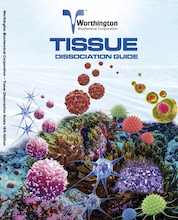For our international customers, please be advised that orders cannot be placed through our website by customers in countries with International Distributor representation.
Worthington Tissue Dissociation Guide
Methods and Materials: Enzymatic Cell Harvesting
Most non-malignant cells growing in vitro move about and divide until they form a monolayer one cell thick completely covering the surfaces of the culture vessel. Movement and proliferation normally cease when confluence is reached. Harvesting cells for study, processing or subculture requires dissociation and detachment of the monolayer. Limited treatment of the cell layer with the enzyme trypsin is the method most frequently applied.
It was formerly thought that trypsin preparations simply hydrolyzed a proteinaceous adhesive bonding substance responsible for the tenacious attachment of cells to their substratum with the resultant detachment of the cells from the culture vessel. It is now felt that the mechanism of action of trypsin in cell harvesting is more complex. This section summarizes recent information on this subject.
Tissue Tables
The Worthington Tissue Tables provide references useful to researchers interested in tissue dissociation and cell harvesting procedures. The references are organized by Tissue and Species type and linked to PubMed citations. The Cell type, Enzymes, and Medium for each reference is provided.
To search by specific criteria, use the Tissue References Search Tool.
